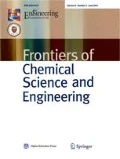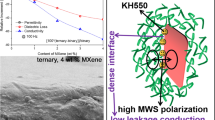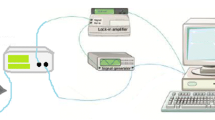Abstract
Recent advances in novel electroactive devices have placed new requirements on material development. High-performance dielectric elastomers with good mechanical stretchability and high dielectric constant are under high demand. However, the current strategy for fabricating these materials suffers from high cost or low thermal stability, which greatly hinders large-scale industrial production. Herein, we have successfully developed a novel strategy for improving the dielectric constant of polymeric elastomers via deep eutectic solvent inclusion by taking advantage of the low cost, convenient and environmentally benign synthesis process and high ionic conductivity from deep eutectic solvents. The as-prepared composite elastomers showed good stretchability and a greatly enhanced dielectric constant with a negligible increase in dielectric dissipation. Moreover, we have proven the universality of our strategy by using different types of deep eutectic solvents. It is believed that low-cost, easy-synthesis and environmentally friendly deep eutectic solvents including composite elastomers are highly suitable for large-scale industrial production and can greatly broaden the application fields of dielectric elastomers.

Similar content being viewed by others
References
Shian S, Bertoldi K, Clarke D R. Dielectric elastomer based “grippers” for soft robotics. Advanced Materials, 2015, 27(43): 6814–6819
Rafsanjani A, Zhang Y, Liu B, Rubinstein S M, Bertoldi K. Kirigami skins make a simple soft actuator crawl. Science Robotics, 2018, 3(15): eaar7555
Duduta M, Wood R J, Clarke D R. Multilayer dielectric elastomers for fast, programmable actuation without prestretch. Advanced Materials, 2016, 28(36): 8058–8063
Poulin A, Rosset S, Shea H R. Printing low-voltage dielectric elastomer actuators. Applied Physics Letters, 2015, 107(24): 244104
Hajiesmaili E, Clarke D R. Reconfigurable shape-morphing dielectric elastomers using spatially varying electric fields. Nature Communications, 2019, 10(1): 1–7
Shi L, Yang R, Lu S, Jia K, Xiao C, Lu T, Wang T, Wei W, Tan H, Ding S. Dielectric gels with ultra-high dielectric constant, low elastic modulus, and excellent transparency. NPG Asia Materials, 2018, 10(8): 821–826
Ke Y, Chen J, Lin G, Wang S, Zhou Y, Yin J, Lee P S, Long Y. Smart windows: electro-, thermo-, mechano-, photochromics, and beyond. Advanced Energy Materials, 2019, 9(39): 1902066
Kim H N, Yang S. Responsive smart windows from nanoparticle-polymer composites. Advanced Functional Materials, 2020, 30(2): 1902597
Kim H N, Ge D, Lee E, Yang S. Multistate and on-demand smart windows. Advanced Materials, 2018, 30(43): 1803847
Xu C, Stiubianu G T, Gorodetsky A A. Adaptive infrared-reflecting systems inspired by cephalopods. Science, 2018, 359(6383): 1495–1500
Pelrine R, Kornbluh R, Pei Q, Joseph J. High-speed electrically actuated elastomers with strain greater than 100%. Science, 2000, 287(5454): 836–839
Mannsfeld S C, Tee B C, Stoltenberg R M, Chen C V H, Barman S, Muir B V, Sokolov A N, Reese C, Bao Z. Highly sensitive flexible pressure sensors with microstructured rubber dielectric layers. Nature Materials, 2010, 9(10): 859–864
Carpi F, Bauer S, De Rossi D. Stretching dielectric elastomer performance. Science, 2010, 330(6012): 1759–1761
Carpi F, Frediani G, Turco S, De Rossi D. Bioinspired tunable lens with muscle-like electroactive elastomers. Advanced Functional Materials, 2011, 21(21): 4152–4158
Quinsaat J E Q, Alexandru M, Nüesch F A, Hofmann H, Borgschulte A, Opris D M. Highly stretchable dielectric elastomer composites containing high volume fractions of silver nanoparticles. Journal of Materials Chemistry. A, Materials for Energy and Sustainability, 2015, 3(28): 14675–14685
Biggs J, Danielmeier K, Hitzbleck J, Krause J, Kridl T, Nowak S, Orselli E, Quan X, Schapeler D, Sutherland W, Wagner J. Electro-active polymers: developments of and perspectives for dielectric elastomers. Angewandte Chemie International Edition, 2013, 52(36): 9409–9421
Sun W, Mao J, Wang S, Zhang L, Cheng Y. Review of recent advances of polymer based dielectrics for high-energy storage in electronic power devices from the perspective of target applications. Frontiers of Chemical Science and Engineering, 2021, 15(1): 18–34
Li P, Wang Y, Gupta U, Liu J, Zhang L, Du D, Foo C C, Ouyang J, Zhu J. Transparent soft robots for effective camouflage. Advanced Functional Materials, 2019, 29(37): 1901908
Zhalmuratova D, Chung H J. Reinforced gels and elastomers for biomedical and soft robotics applications. ACS Applied Polymer Materials, 2020, 2(3): 1073–1091
Ilami M, Bagheri H, Ahmed R, Skowronek E O, Marvi H. Materials, actuators, and sensors for soft bioinspired robots. Advanced Materials, 2021, 33(19): 2003139
Ning N, Ma Q, Liu S, Tian M, Zhang L, Nishi T. Tailoring dielectric and actuated properties of elastomer composites by bioinspired poly(dopamine) encapsulated graphene oxide. ACS Applied Materials & Interfaces, 2015, 7(20): 10755–10762
Panahi M, Zahiri B, Noroozi M. Graphene-based composite for dielectric elastomer actuator: a comprehensive review. Sensors and Actuators. A, Physical, 2019, 293: 222–241
Cakmak E, Fang X, Yildiz O, Bradford P D, Ghosh T K. Carbon nanotube sheet electrodes for anisotropic actuation of dielectric elastomers. Carbon, 2015, 89: 113–120
Zhao H, Zhang L, Yang M H, Dang Z M, Bai J. Temperature-dependent electro-mechanical actuation sensitivity in stiffness-tunable BaTiO3/polydimethylsiloxane dielectric elastomer nanocomposites. Applied Physics Letters, 2015, 106(9): 092904
Luo S, Yu S, Sun R, Wong C P. Nano Ag-deposited BaTiO3 hybrid particles as fillers for polymeric dielectric composites: toward high dielectric constant and suppressed loss. ACS Applied Materials & Interfaces, 2014, 6(1): 176–182
Bartlett M D, Fassler A, Kazem N, Markvicka E J, Mandal P, Majidi C. Stretchable, high-k dielectric elastomers through liquid-metal inclusions. Advanced Materials, 2016, 28(19): 3726–3731
Pan C, Markvicka E J, Malakooti M H, Yan J, Hu L, Matyjaszewski K, Majidi C. A liquid-metal-elastomer nanocomposite for stretchable dielectric materials. Advanced Materials, 2019, 31(23): e1900663
Ankit T N, Ho F, Krisnadi F, Kulkarni M R, Nguyen L L, Koh S J A, Mathews N. High-k, ultrastretchable self-enclosed ionic liquid-elastomer composites for soft robotics and flexible electronics. ACS Applied Materials & Interfaces, 2020, 12(33): 37561–37570
Shi L, Zhang C, Du Y, Zhu H, Zhang Q, Zhu S. Improving dielectric constant of polymers through liquid electrolyte inclusion. Advanced Functional Materials, 2021, 31(8): 2007863
Zhong M, Tang Q F, Zhu Y W, Chen X Y, Zhang Z J. An alternative electrolyte of deep eutectic solvent by ChCl and EG for wide temperature range supercapacitors. Journal of Power Sources, 2020, 452: 227847
Zhao J, Zhang J, Yang W, Chen B, Zhao Z, Qiu H, Dong S, Zhou X, Cui G, Chen L. “Water-in-deep eutectic solvent” electrolytes enable zinc metal anodes for rechargeable aqueous batteries. Nano Energy, 2019, 57: 625–634
Parnham E R, Drylie E A, Wheatley P S, Slawin A M, Morris R E. Ionothermal materials synthesis using unstable deep-eutectic solvents as template-delivery agents. Angewandte Chemie International Edition, 2006, 118(30): 5084–5088
García-Argüelles S, Serrano M, Gutiérrez M C, Ferrer M L, Yuste L, Rojo F, del Monte F. Deep eutectic solvent-assisted synthesis of biodegradable polyesters with antibacterial properties. Langmuir, 2013, 29(30): 9525–9534
Zhang C, Ding Y, Zhang L, Wang X, Zhao Y, Zhang X, Yu G. A sustainable redox-flow battery with an aluminum-based, deep-eutectic-solvent anolyte. Angewandte Chemie International Edition, 2017, 56(26): 7454–7459
Wu J, Liang Q, Yu X, Lü Q F, Ma L, Qin X, Chen G, Li B. Deep eutectic solvents for boosting electrochemical energy storage and conversion: a review and perspective. Advanced Functional Materials, 2021, 31(22): 2011102
Tadros T F. Fundamental principles of emulsion rheology and their applications. Colloids and Surfaces. A, Physicochemical and Engineering Aspects, 1994, 91: 39–55
Style R W, Boltyanskiy R, Allen B, Jensen K E, Foote H P, Wettlaufer J S, Dufresne E R. Stiffening solids with liquid inclusions. Nature Physics, 2015, 11(1): 82–87
Nan C W, Birringer R, Clarke D R, Gleiter H. Effective thermal conductivity of particulate composites with interfacial thermal resistance. Journal of Applied Physics, 1997, 81(10): 6692–6699
Acknowledgements
This work was supported by the National Natural Science Foundation of China (Grant No. 22078276), the Program for Guangdong Introducing Innovative and Entrepreneurial Teams (Grant No. 2017ZT07C291), Shenzhen Science and Technology Program (Grant No. KQTD20170810141424366), Shenzhen Key Laboratory of Advanced Materials Product Engineering (Grant No. ZDSYS20190911164401990). Qi Zhang thanks the Presidential Fund (Grant No. PF01000949) for supporting his research at CUHK-Shenzhen. Dr. Yifeng Sheng is thanked for the advice on emulsion preparation. Prof. Xilin Wang and Ms. Jinfeng Peng from Tsinghua Shenzhen International Graduate School, Prof. Zhijun Dong and Ms. Lili Wu from Shenzhen Institute of Information Technology are thanked for their support in sample testing.
Author information
Authors and Affiliations
Corresponding author
Rights and permissions
About this article
Cite this article
Zhang, C., Zhang, Q. Deep eutectic solvent inclusions for high-k composite dielectric elastomers. Front. Chem. Sci. Eng. 16, 996–1002 (2022). https://doi.org/10.1007/s11705-022-2138-2
Received:
Accepted:
Published:
Issue Date:
DOI: https://doi.org/10.1007/s11705-022-2138-2




